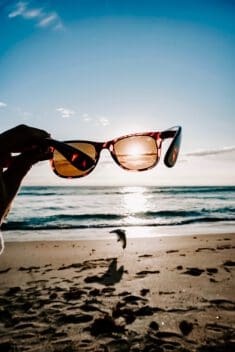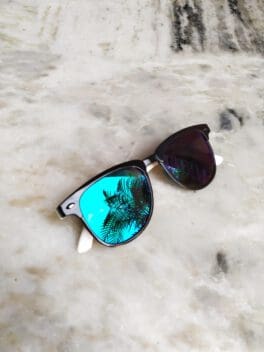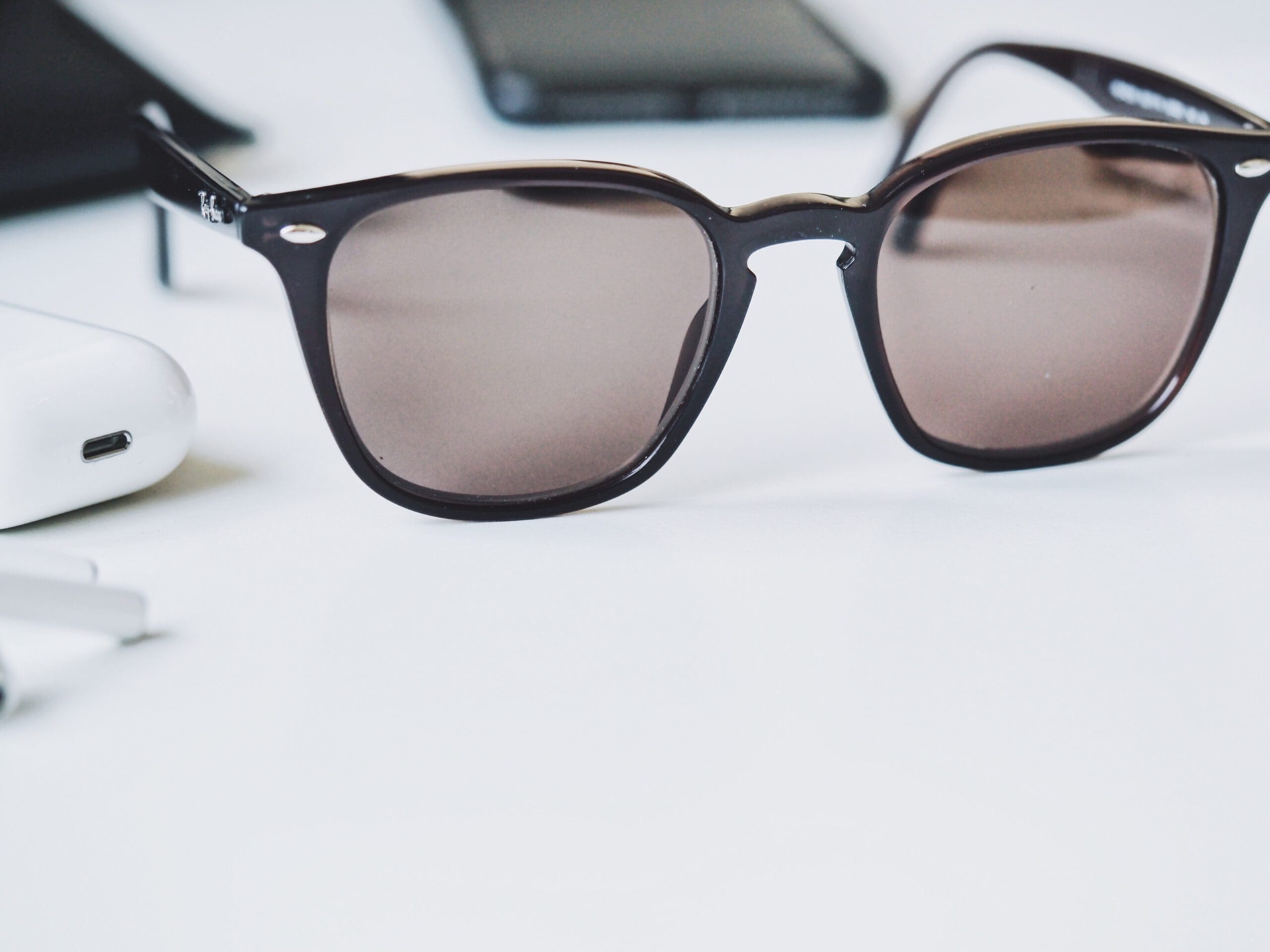Does Anti-Reflective Coating for Glasses Work? (How?)
Home / Everything About Glasses /
Last Updated:
Anti-reflective coatings, also known as AR coatings or anti-glare coatings, are applied to glasses via a series of layers adhered to the front and back of the lenses. These layers block certain wavelengths of light, helping to reduce reflection.
Table of Contents
This coating generally costs about $20 to $90 to apply to a pair of glasses. AR coatings developed a bad reputation for quickly deteriorating in the past, but modern AR coatings usually last a fairly long time unless exposed to extreme conditions.
AR coating makes glass less reflective (hence the name), and this can make your glasses look nicer in photos and under bright lights. There is some debate about how much they help with glare, although many claim they reduce glare to at least some degree. Some AR coatings also have additional benefits, such as making glasses less prone to scratching.

Some people think anti-reflective coatings prevent UV rays from damaging the eyes, but this is not true (although such features can be combined into one pair of glasses). The American Academy of Ophthalmology has been critical of claims that AR coatings can provide significant glare resistance. They say glare resistance is generally only possible with polarized lenses, which tend to have a dark tint (making them unsuitable for night driving).
Of the options available for anti-reflective coatings, Crizal coatings are regarded as some of the best by multiple reviewers. These can be expensive though. For a cheaper coating, you will primarily want something that is not likely to smudge.
Keep in mind that AR coatings are not essential. They may only offer a minor benefit to the wearer.
Anti-Reflective Coatings
Anti-reflective coating, also called AR coating and anti-glare coating, is when a series of layers are adhered to the front and back of lens (or just the back for polarized lenses) to reduce the reflections that normally bounce off a lens.
Each of these layers is designed to block specific wavelengths of light, allowing the glasses to have anti-reflective properties with basically no noticeable drawbacks (beyond increased cost).
This coating can cost anywhere from $20 to $90 to add to a pair of glasses. This cost is sometimes covered by insurance, although this will depend on your exact plan.

Many doctors recommend getting an anti-reflective coating. In some cases, a coating may even save you money in the long run since the coating can reduce scratching, making a pair of glasses last longer.
In the past, AR coating got a bad reputation in the United States. The technology was still in its infancy and had a serious durability problem. Nearly all modern lenses should last much longer, although there are still some drawbacks (discussed below).
What Does This Coating Do?
The short answer is that each extra layer blocks more wavelengths of light.
The longer answer is more complicated, with some claims more controversial than others. Anti-reflective coatings may be able to:
- Make you more photogenic. Probably the least controversial and demonstrably true claim about AR lenses is that they make your glasses have less of a reflection. This can make you appear more fashionable. They can specifically be nice in high light environments, such as with photo flashes, as your eyes will be more visible to others.
- Reduce glare. The idea that an AR coating’s ability to reduce reflections would also reduce glare from light (which may normally bounce off your glasses, almost making it appear like a wall of light in front of your eyes) makes logical sense. However, the validity of this claim is sometimes doubted (discussed more below).
- Increase glasses durability. Not necessarily true of all coatings, many anti-reflective coatings (such as Crizal or the TechShield line) make glasses more scratch-resistant and durable. This is why, despite their increased cost, they can sometimes actually save you money since you may need to replace glasses less often.
Misconceptions and Controversies
There are some things often believed, and even claimed by sellers, about anti-reflective coatings that either aren’t true or are at least debated and controversial.
One of the most important misconceptions to dispel is the notion that an AR coating equals UV protection. An AR coating does not protect your eyes from UV rays (such as those from the sun), which can cause eye damage.
You deserve clear vision. We can help.
With 135+ locations and over 2.5 million procedures performed, our board-certified eye surgeons deliver results you can trust.
Your journey to better vision starts here.
While many pairs of sunglasses come with both an anti-reflective coating and UV protection, it is important to know that not all pairs of glasses with an AR coating protect your eyes from sunlight. Be sure to research the coating you’re choosing carefully as even some sellers, willfully or not, may have misinformation on their sites claiming a coating can protect your eyes from the sun when it cannot.
Websites and dispensing opticians often claim AR coating protects against glare. This is a claim you will see almost everywhere that offers anti-reflective coatings. However, the American Academy of Ophthalmology (AAO) takes issue with this claim.

In a 2015 response to a question on the nature of anti-reflective coatings on glasses, AAO claims the ability for an AR coating to protect against glare is very slim. They go on to explain that in actuality only polarized lenses, which only come in dark tints, can properly guard against glare.
Whether one should side with AAO on this issue is difficult to say. There is little hard data on the subject. Most information on the lenses is either anecdotal or coming from a source biased toward the coating being portrayed positively, such as a manufacturer or retailer. AAO’s criticisms are certainly worth bearing in mind, as the organization is a reliable source of information.
Why Modern AR Coatings Are Durable
Anti-reflective coatings have come a long since they were introduced. Original AR technology was ground-breaking, of course, but it had its flaws. AR lenses were more easily scratched than non-AR lenses, the coatings often peeled away over time and lenses seemed in constant need of cleaning.
Many of the AR lens problems were solved in the early 2000s, and modern manufacturing continues to make improvements in the lens performance. AR coatings are now a misnomer: they aren’t coatings at all. Rather, anti-reflection chemicals are part of the lens production process. These days, there’s nothing to peel off or scratch.
What’s more, many modern AR lenses include a chemical composition that helps keep dirt, water marks and smudges away from the lens.
The average effective period for AR lenses is up to two years with proper care and without constant exposure to extreme temperatures. If you work in a profession that will make your glasses-wearing more demanding, consider investing in an eyeglass insurance policy—one that will enable you to replace your eyewear more than every two years. (Most vision policies permit replacement glasses once every two years.)
How to Improve Your Lens Durability
Proper care for long-term durability of anti-reflective lenses includes following the basic cleaning rules for all glasses:
- Wipe your lenses only with soft clothes designed for eyeglass cleaning
- Never clean your glasses with your shirt or blouse
- Never clean your glasses with tissue or toilet paper
- Never clean your lenses with washcloths or towels
- Use a spray cleaner that does not contain alcohol, which can break down the ability of your lens composition
Top Anti-Reflective Coatings Brands
For those on a budget, even a very basic anti-reflective coating should generally suffice. This is doubly true if you are frequently cycling through prescriptions as you and your doctor try to find what is best for your needs. You primarily will just want a coating that is not prone to smudging or scratching.
Hundreds of companies across the globe manufacture and distribute anti-reflective coatings and lenses. Some of the more popular brands come from Essilor, Asahi Glass, Essilor, PPG Industries, Royal DSM and Zeiss.
Essilor (Crisal)
Essilor’s top anti-reflective lenses are branded Crizal and Crizal A2, and they rank as one of the most popular lenses sold today.
Asahi Glass (Clearsight)
Asahi Glass has its Clearsight brand, an anti-reflective glass product that is enhanced with chemical-resistant and improved weather coating. It also has an anti-reflective coating for outdoor wear under brands names Solite Plus and Solatex Plus.
PPG Industries (SOLARPHIRE AR)
Sold under the brand name SOLARPHIRE AR, PPG’s anti-reflective glass lens boasts anti-glare, anti-smudge and anti-reflective coatings to protect and enhance vision for glasses and a number of other products with display screens (tablets, laptops, monitors, TVs and cell phones).
ZEISS
ZEISS sells its anti-reflective coatings under the brands DuraVision Platinum, DuraVision Silver and LotuTec. It recently unveiled its PureCoat lens, which it says improves reflection, night vision and sight. ZEISS and DuPont jointly produced Teflon Clear Coat Lenses for “the clearest anti-reflective coatings.”
Various AR Brands
Some quality brand name AR coatings are:
- Crizal Alize’ (Essilor)
- Crizal Avance’ with Scotchguard (Essilor)
- Hi Vision (Hoya)
- Super Hi Vision with ViewProtect (Hoya)
- Teflon Clear Coat (Zeiss)
- Carat Advantage (Zeiss)
Other premium AR lenses (in alphabetical order):
- BluCrystal
- Crizal Easy UC
- Crizal Prevencia Kids
- Hi Vision
- Hoya Premium
- Kirland Premium AR
- KODAK CleAR
- RF Endura EZ
- VISO
- Zperio Sun UV
- Xperio Sun UV with mirrors
- Zeiss Dura Vision Chrome
You deserve clear vision. We can help.
With 135+ locations and over 2.5 million procedures performed, our board-certified eye surgeons deliver results you can trust.
Your journey to better vision starts here.
References
- Anti-Reflective (AR) Coating. Eyeglasses.com.
- TechShield Anti-Reflective Coatings. Vision Service Plan.
- What Are the Advantages of Anti-Reflective Coatings on Eyeglasses, if Any? (February 2015). American Academy of Ophthalmology.
- Antireflective Lens Coatings: Waste of Money or Must-Have for Happy Eyes? (November 2015). EndMyopia.
- UV Protection and Glare Protection. (July 2018). Zeiss.
- Crizal. Essilor of America.
- What Is the Cost of Crizal Lenses? (February 2019). cost-finder.com.
- The Best Anti-reflective Coatings of 2019. (August 22, 2019). Eyeson Eyecare.
- Antireflection Coating. (July 2021). Photonics.
- Top 5 Vendors in the Anti-Reflective Coaching Market from 2017 to 2021. (April 24, 2017). Technavio.
- Anti-Reflective Coating for Eyeglasses: Worth the Money? (May 28, 2020). RX-Able.
- What You Need to Know about Eyeglass Lens Coatings. (March 23, 2020). Consumer Reports.
- Progressive tier classifications 2020. (January 1, 2020). EyeMed.
This content is for informational purposes only. It may have been reviewed by a licensed physician, but is not intended to serve as a substitute for professional medical advice. Always consult your healthcare provider with any health concerns. For more, read our Privacy Policy and Editorial Policy.
